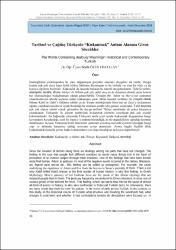| dc.contributor.author | Eratalay, Sevda Özen | |
| dc.date.accessioned | 2019-06-10T13:04:56Z | |
| dc.date.available | 2019-06-10T13:04:56Z | |
| dc.date.issued | 2018 | en_US |
| dc.identifier.uri | https://dergipark.org.tr/download/article-file/606719 | |
| dc.identifier.uri | https://hdl.handle.net/11630/6428 | |
| dc.description | Since the creation of human being there are feelings among his parts that have not changed. The
feeling is the case that people feel different emotions to wards many things and is the form of
perception of an eventor subject through these emotions. One of the feelings that have been known
since first human, Adam, is jealousy. In most of the negative events occurred in the history, literature,
art, legend sand stories etc., this feeling can be called as protagonist. For example, the cause
underlying the expulsion of Adam and Eve from the heaven is Satan’s jealousy of them. There a son
why Kabil killed Habil, known as the first murder of human history, is also this feeling. In Greek
Mythology, Hera’s jealousy of her husband Zeus are the result of this illness (feeling) that not
healsand people feed in them. The jealousy frequently encountered in Divan literature, is more one of
various grinds of the beloved for lover. This feeling, which has beens how into be the cause of almost
all kind of events in history, is also very confronted in historical Turkish texts. In otherwords, there
are many words that meet the verb ‘be jealous’ in the works of early period Turkish. In this context, in
this study, in the historical course of Turkish what structure and meaning the word/verb had, what
changes it underwent and whether it had connotations besides its denotations were focused on. In short, the answer to the question of which structure and meaning of the word/verb occurred was
sought. In addition, information about usage patterns and the irmeanings in Turkey Turkish dialects
were given. Today, in Standard language whether there are other usages forth everb ‘be jealous’ or the
word ‘jealousy’ was briefly mentioned. | en_US |
| dc.description.abstract | nsanoğlunun yaradılışından bu yana değişmeyen parçaları arasında duyguları da vardır. Duygu
kişinin pek çok olaya karşı farklı hislere bürünme durumudur ve bu hislerle var olan bir olayı ya da
konuyu algılama biçimidir. Kıskançlık da insanda bulunan bu önemli duygulardandır. Öyle ki tarihte,
edebiyatta, sanatta, efsane, hikâye vb. bilinen pek çok tarihî olay ya da durumun altında yatan hemen
her olumsuzluğun başkahramanı olarak gösterilebilir. Örneğin Hz. Âdem ve Havva’nın cennetten
çıkarılmalarının altında şeytanın onları kıskanması yatar. Hatta insanlık tarihinin ilk cinayeti olarak
bilinen Kabil’in Habil’i öldürme sebebi ya da Yunan mitolojisinde Hera’nın eşi Zeus’u kıskanması
uğruna yaptıkları,insanların içinde beslediği bu onulmaz derdin (duygunun) sonucudur. Tarih boyunca
pek çok olayın sebebi olarak gösterilen bu duygu tarihsel Türkçe metinlerde de çokça karşımıza
çıkmaktadır. Türkçenin ilk dönem eserlerinde kıskanmak eylemini karşılayan pek çok sözcük
bulunmaktadır. Bu bağlamda çalışmada Türkçenin tarihi seyri içinde kıskanmak duygusunun hangi
kavramlarla karşılandığı, nasıl bir yapıya ve anlama büründüğü, ne tür değişikliklere uğradığı üzerinde
durulmuştur. Kısaca; Türkçenin farklı dönemleri içerisinde yazılmış eserlerde eylemin/sözcüğün hangi
yapı ve anlamda karşımıza çıktığı sorusuna cevap aranmıştır. Ayrıca bugün ölçünlü dilde
kıskanmak/kıskançlık yerine başka kullanımların var olup olmadığına da kısaca değinilmiştir. | en_US |
| dc.language.iso | tur | en_US |
| dc.identifier.doi | 10.32709/akusosbil.454515 | en_US |
| dc.rights | info:eu-repo/semantics/openAccess | en_US |
| dc.subject | Kıskançlık ve türleri, eski Türkçe, Karahanlı Türkçesi, etimoloji | en_US |
| dc.title | Tarihsel ve Çağdaş Türkçede “Kıskanmak” Anlam Alanına Giren Sözcükler | en_US |
| dc.title.alternative | The Words Containing Jealousy Meaningin Historical and Contemporary Turkish | en_US |
| dc.type | article | en_US |
| dc.relation.journal | Sosyal Bilimler Dergisi | en_US |
| dc.department | Afyon Kocatepe Üniversitesi | en_US |
| dc.authorid | 0000-0003-2236-1678 | en_US |
| dc.identifier.volume | 20 | en_US |
| dc.identifier.startpage | 11 | en_US |
| dc.identifier.endpage | 27 | en_US |
| dc.identifier.issue | 3 | en_US |
| dc.relation.publicationcategory | Makale - Uluslararası Hakemli Dergi - Kurum Öğretim Elemanı | en_US |



















